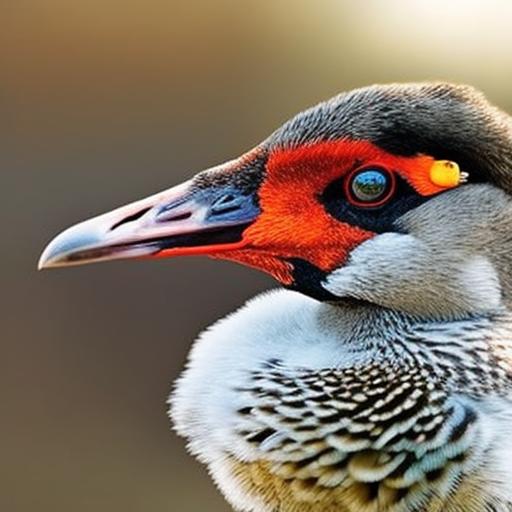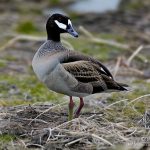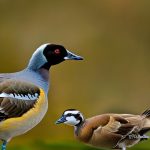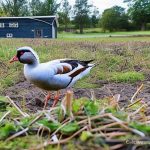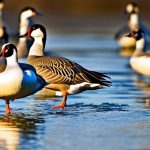Geese are fascinating creatures that exhibit complex social behavior and have unique ways of communicating with each other. One behavior that is particularly important to understand is flaring, which is a defense mechanism used by geese to protect themselves from potential threats. Flaring plays a crucial role in the survival of geese in the wild, and understanding this behavior is essential for conservation efforts aimed at protecting these magnificent birds.
Key Takeaways
- Geese flare as a defense mechanism to protect themselves from perceived threats.
- Human interference, such as noise and movement, can trigger geese to flare and disrupt their natural behavior.
- Understanding geese behavior and the factors that trigger flaring can help minimize human interference and reduce negative impacts on ecosystems.
- Effective communication and strategies, such as creating buffer zones and limiting disturbance, can help minimize geese flaring in different environments.
- Conservation efforts, such as habitat protection and education, can help protect geese from flaring and maintain healthy ecosystems.
Understanding Geese Behavior
Geese are highly social animals that live in flocks and exhibit a wide range of social behaviors. They form strong pair bonds and often mate for life. Geese communicate with each other through a variety of vocalizations, body movements, and visual displays. They also have a well-developed system of hierarchy within their flocks, with dominant individuals taking the lead in various activities such as foraging and migration.
Migration is another important aspect of geese behavior. Many species of geese undertake long-distance migrations, traveling thousands of miles each year between their breeding grounds and wintering areas. They navigate using a combination of visual landmarks, celestial cues, and magnetic fields. Migration allows geese to take advantage of seasonal resources and avoid harsh weather conditions.
The Significance of Flaring in Geese
Flaring is a behavior exhibited by geese when they feel threatened or perceive danger. It involves the rapid spreading of wings and loud honking, which serves as a warning signal to other members of the flock. Flaring is an important defense mechanism that helps geese survive in the wild by deterring potential predators and keeping the flock safe.
Flaring serves several purposes for geese. Firstly, it helps to intimidate predators by making the geese appear larger and more threatening. The loud honking also serves to alert other members of the flock to the presence of danger, allowing them to take evasive action if necessary. Additionally, flaring can confuse predators by creating a chaotic and unpredictable environment, making it more difficult for them to single out individual geese.
Factors that Trigger Geese to Flare
There are several factors that can trigger geese to flare, both natural and human-induced. In the wild, natural triggers for flaring include the presence of predators such as foxes, coyotes, and birds of prey. Geese have evolved to be highly vigilant and are able to detect potential threats from a distance. When they perceive danger, they will immediately go into flaring mode to protect themselves and their flock.
Human activities can also trigger geese to flare. Loud noises, sudden movements, and disturbances in their habitat can all cause geese to feel threatened and respond with flaring. This is particularly common in urban areas where geese have become accustomed to human presence but are still wary of potential threats. It is important for humans to be mindful of their actions and avoid causing unnecessary stress to geese.
Impact of Human Interference on Geese Flaring
Human interference can have negative effects on geese behavior, particularly when it comes to flaring. Activities such as loud construction work, fireworks, and excessive recreational activities near geese habitats can cause significant stress to the birds and disrupt their natural behavior patterns. This can lead to increased flaring and a decrease in overall fitness and reproductive success for the flock.
Examples of human activities that trigger geese flaring include the use of motorized watercraft in close proximity to nesting sites, which can cause disturbance and disrupt breeding activities. Additionally, feeding geese in public areas can lead to an over-reliance on human-provided food sources, which can disrupt natural foraging behaviors and lead to increased aggression between individuals.
Strategies to Minimize Geese Flaring
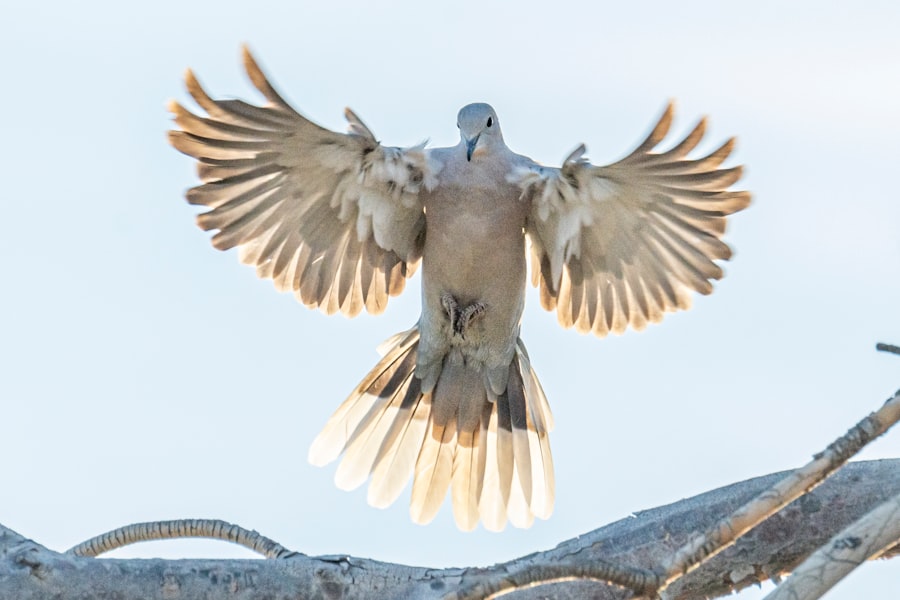
To minimize geese flaring and reduce human interference in their habitats, there are several best practices that individuals and communities can follow. Firstly, it is important to maintain a respectful distance from geese and avoid approaching them too closely. This will help to minimize stress and allow the birds to carry out their natural behaviors without disturbance.
It is also important to avoid feeding geese, as this can disrupt their natural foraging behaviors and lead to increased aggression and dependence on human-provided food sources. Additionally, communities can implement measures such as noise reduction strategies and the establishment of protected areas to minimize disturbance to geese habitats.
Geese Flaring as a Defense Mechanism
Flaring is a highly effective defense mechanism for geese, allowing them to protect themselves and their flock from potential threats. When geese flare, they create a visually intimidating display by spreading their wings and honking loudly. This can deter predators and make them think twice before approaching the flock.
Flaring also serves as a warning signal to other members of the flock, alerting them to the presence of danger. This allows the flock to take evasive action and escape from potential threats. By working together and communicating effectively, geese are able to increase their chances of survival in the wild.
The Role of Communication in Geese Flaring
Communication plays a crucial role in geese flaring behavior. When a goose perceives danger and goes into flaring mode, it sends a clear signal to other members of the flock that there is a potential threat nearby. This communication allows the flock to coordinate their response and take appropriate action to protect themselves.
Geese communicate with each other through a variety of vocalizations, body movements, and visual displays. The loud honking during flaring serves as an alarm call, alerting other members of the flock to the presence of danger. Geese also use visual displays such as head bobbing and neck stretching to communicate dominance and establish hierarchy within the flock.
Geese Flaring in Different Environments
Geese behavior can vary depending on the environment they inhabit. In urban environments, geese have become accustomed to human presence and may be less likely to flare in response to human activities. However, they may still exhibit flaring behavior if they perceive a direct threat or disturbance.
In rural environments, geese are more likely to be exposed to natural triggers for flaring, such as predators. They may also be more sensitive to human interference, as they are less accustomed to human presence. In these environments, it is important for humans to be mindful of their actions and avoid causing unnecessary stress to geese.
Geese Flaring and its Effect on Ecosystems
Geese behavior, including flaring, plays an important role in maintaining healthy ecosystems. Geese are herbivores and feed on a variety of plant species, including grasses and aquatic vegetation. By grazing on these plants, geese help to control their growth and prevent overgrowth in certain areas.
Additionally, geese act as seed dispersers by consuming fruits and excreting the seeds in different locations. This helps to promote plant diversity and allows for the colonization of new areas by plant species. Without the presence of geese and their grazing behavior, ecosystems could become imbalanced and dominated by certain plant species.
Conservation Efforts to Protect Geese from Flaring
Conservation efforts aimed at protecting geese habitats are crucial for the long-term survival of these birds. Many organizations and individuals are working to protect and restore wetland habitats that are important for geese breeding and migration. This includes the establishment of protected areas, habitat restoration projects, and public education initiatives.
It is also important for communities to implement measures to minimize human interference in geese habitats. This can include the enforcement of regulations regarding feeding and disturbance of geese, as well as the implementation of noise reduction strategies in areas where geese are present.
Understanding geese behavior, including flaring, is essential for conservation efforts aimed at protecting these magnificent birds. Flaring is a defense mechanism that helps geese survive in the wild by deterring potential predators and keeping the flock safe. Human interference can disrupt geese behavior and lead to increased flaring, which can have negative effects on their overall fitness and reproductive success.
By following best practices for interacting with geese and minimizing human interference in their habitats, we can help to protect these birds and ensure the health of their ecosystems. Conservation efforts aimed at protecting geese habitats are crucial for the long-term survival of these birds and should be supported by individuals, communities, and governments alike. Together, we can ensure a future where geese continue to thrive in the wild.
If you’re interested in learning more about poultry and their behaviors, you might find this article on “How Long for Chicken Eggs to Hatch Naturally” from Poultry Wizard quite fascinating. It delves into the intricacies of the hatching process and provides valuable insights for chicken breeders. Understanding the natural incubation period can help you better manage your flock and ensure successful hatching. So, if you’re curious about the wonders of nature and want to enhance your knowledge of poultry, be sure to check out this informative article.
Meet Walter, the feathered-friend fanatic of Florida! Nestled in the sunshine state, Walter struts through life with his feathered companions, clucking his way to happiness. With a coop that’s fancier than a five-star hotel, he’s the Don Juan of the chicken world. When he’s not teaching his hens to do the cha-cha, you’ll find him in a heated debate with his prized rooster, Sir Clucks-a-Lot. Walter’s poultry passion is no yolk; he’s the sunny-side-up guy you never knew you needed in your flock of friends!

